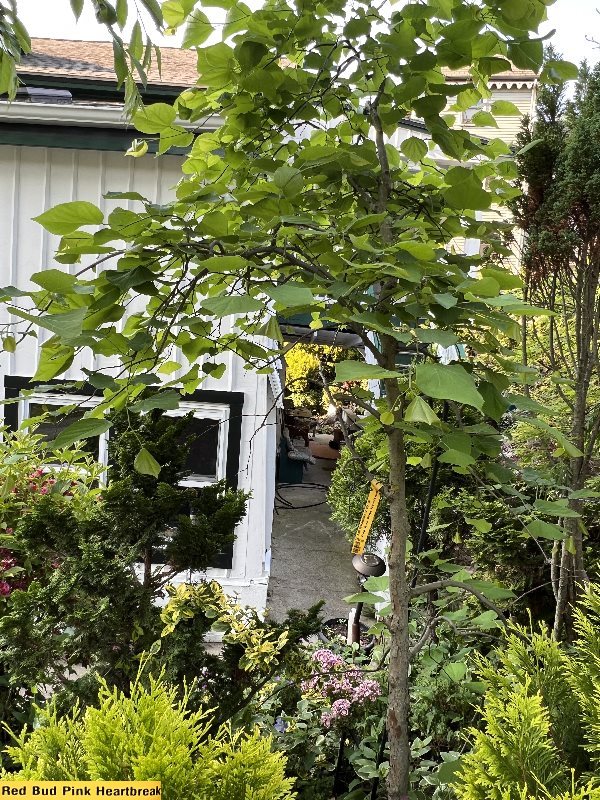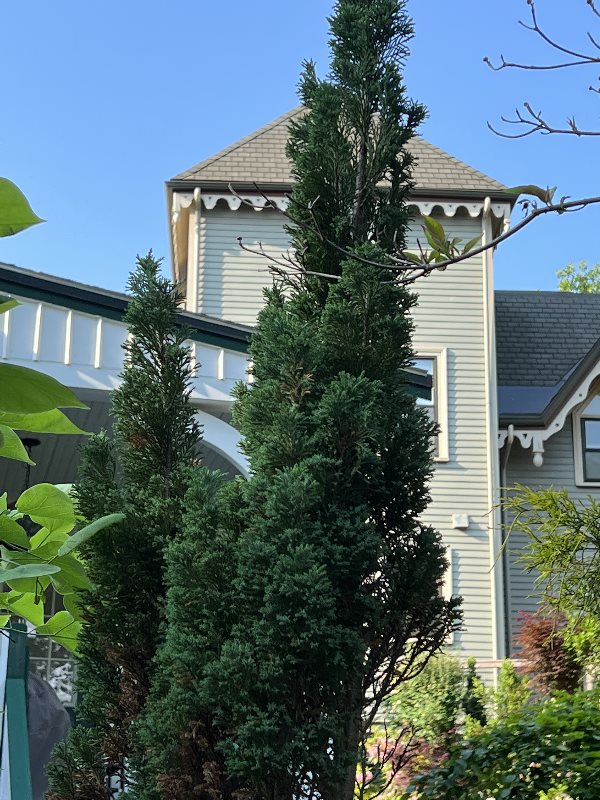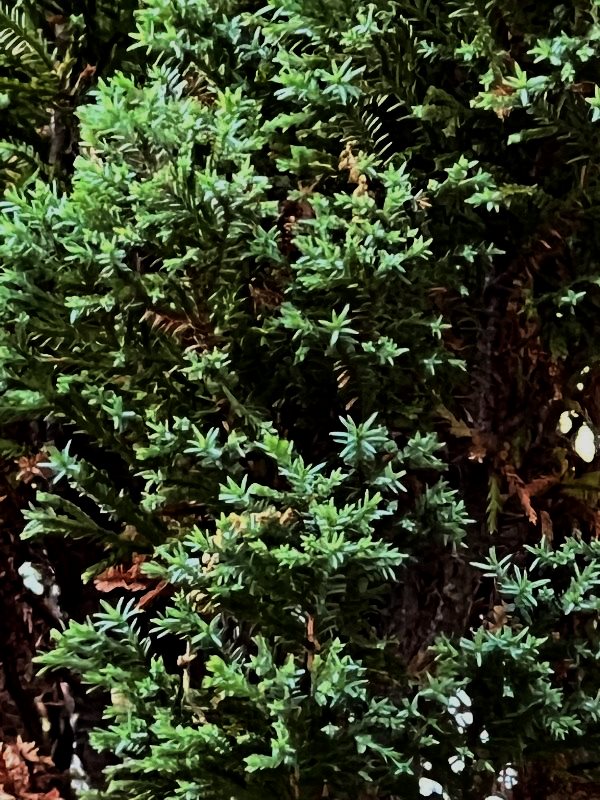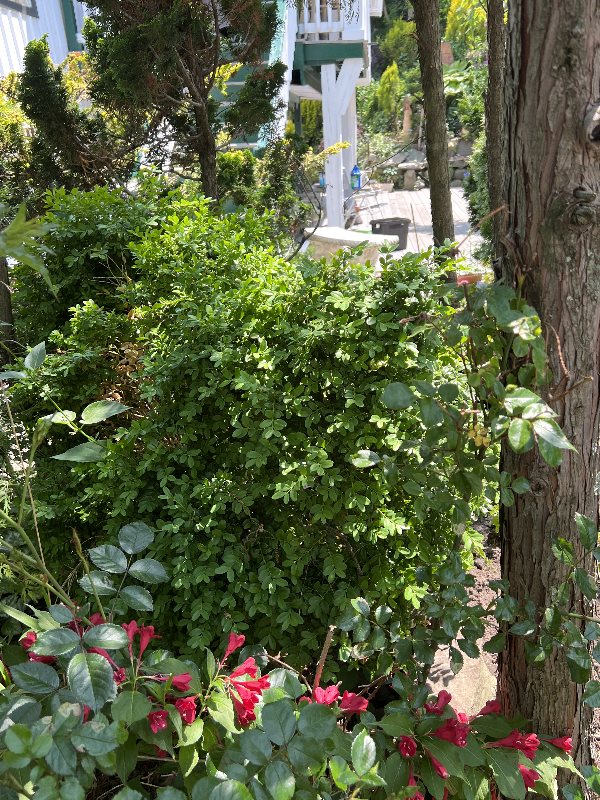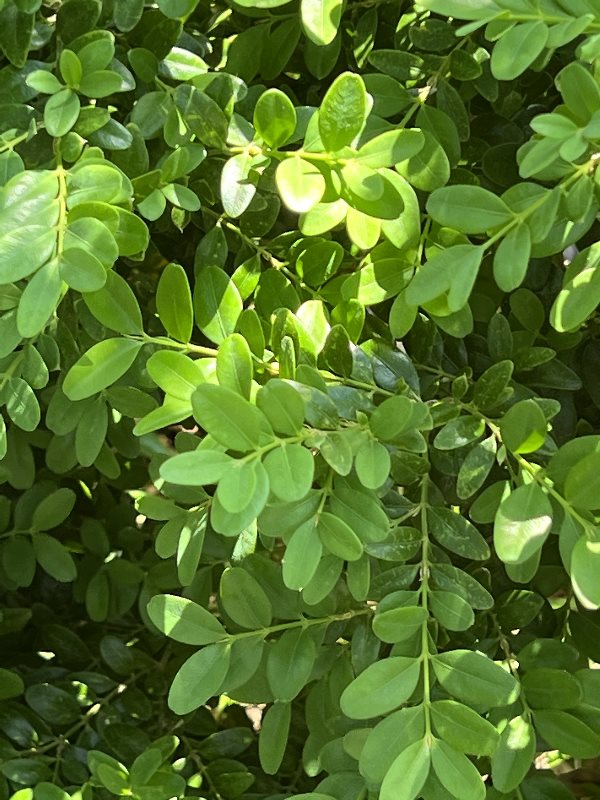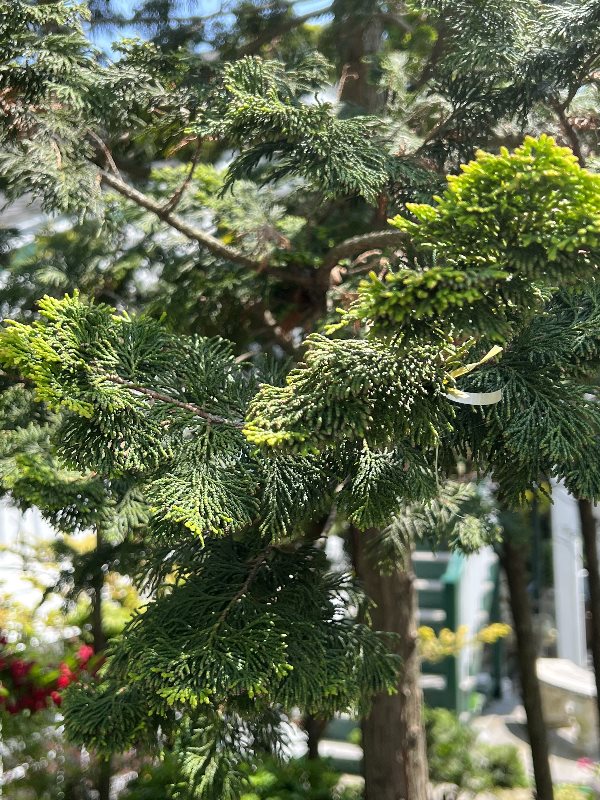- leaves
-
1. Leaves with thin, flat, blades, more than 5 mm wide and deciduous. Angiosperms (“broad-leaved trees”) 2 Angiosperms 1. Leaves needle-like or scale-like, less than 5 mm wide, evergreen in all species (except Larix with needles in dense spirals, falling in autumn). Gymnosperms Gymnosperms Glossary of terms - Dictionary of Leaves Waynes Word
- What is an Evergreen?
- Conifers
- Leaves have needles –
- tend to be pointier than the Yew family needle
- cedars (Cedrus),
- firs/spruce (Abies, Picea),
- hemlocks (Tsuga), an
- pines (Pinus)
- tend to be pointier than the Yew family needle
- Leaves have needles –
- Cypress family (Cupressaceae):
- arborvitae (Thuja)
- Chamaecyparis,
- Cryptomeria,
- Cunninghamia,
- Hesperocyparis,
- junipers (Juniperus),
- and hybrids such as Leyland cypress (x Hesperotropsis leylandii)
- Yew family (Taxaceae):
- Leaves have needles –
- tend to be broader than the conifer family needles
- Cephalotaxus,
- Taxus, and
- Torreya.
- tend to be broader than the conifer family needles
- Leaves have needles –
three distinct types of evergreens:
conifers,
pointy needles for leaves
broadleaf, and
scale leaf trees
flat, scaly leaf structure
flat and soft, overlapping like roof shingles, or feathery
developed to help
conserve moisture in dry, sandy areas.
.
Arbor Vitae
flattened in one plane.
have a raised gland on the back and
young leaves that are
more awl-like
than scale-like.
Cypress
scale-like leaves in
four rows on
rounded branches.
They look like they have been braided
Junipers
have scaly foliage that is flattened
but also
sharp and pointed.
leaves grow in whorls
can be scale-like or awl-like.
One plant can have both types of leaves
Read more at Gardening Know How: Scale Leaf Evergreen Varieties: What Is A Scale Leaf Evergreen Tree https://www.gardeningknowhow.com/ornamental/trees/tgen/scale-leaf-evergreen-varieties.htm
Evergreens
RedBuds
Beeches
Maples
- Japanese Maples
Colorado Blue Spruce
Nana Lutea Dwarf Hinoki Cypress Yellow tinge
Blue Star Juniper
Weeping Norway Spruce
lemon Thread False Mop Cypress
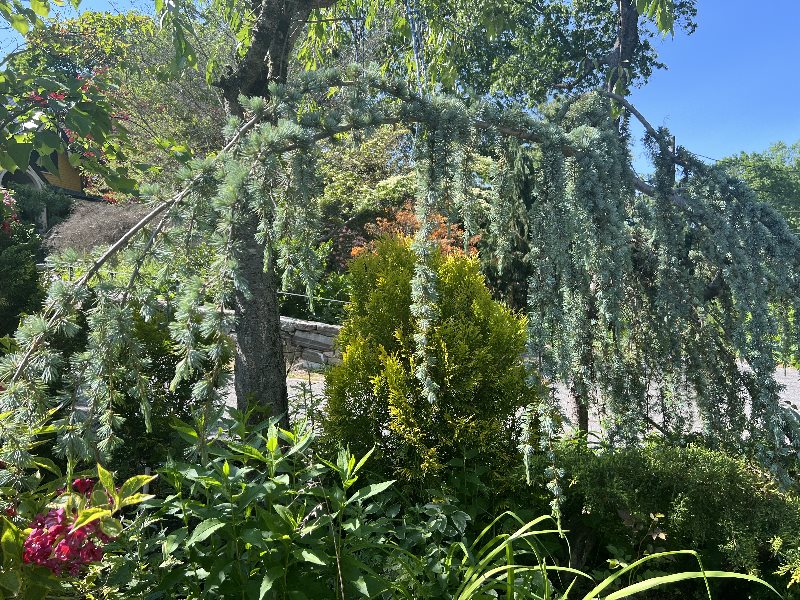
Cedrus atlantica ‘Glauca Pendula’
It is a conifer with weeping growth form, slowly reaching 15′-25′ tall and wide. Its silver blue, needle-like leaves are 1″ long and thin. Best in full sun and needs occasional watering once it’s established. Excellent for rock garden with horizontal pendant branching.
Ashley Davidoff TheCommonVein.net
Our Garden
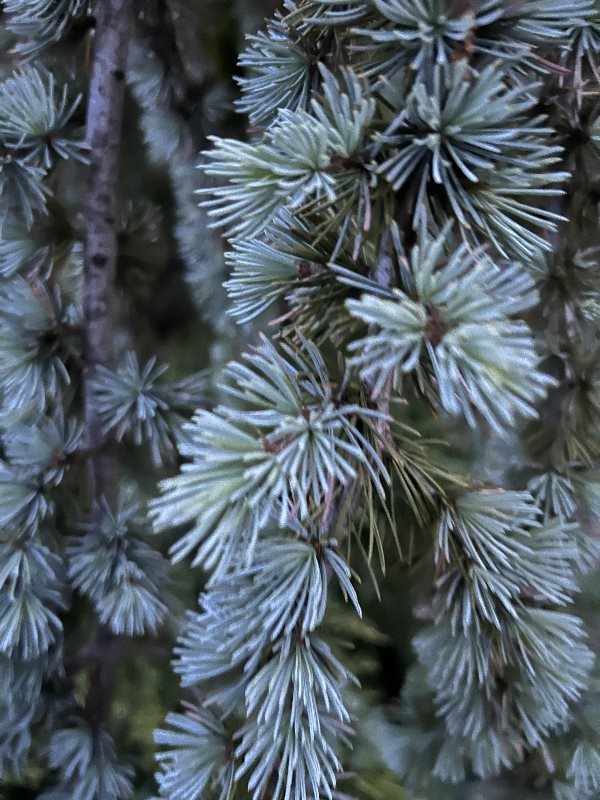
Cedrus atlantica ‘Glauca Pendula’
It is a conifer with weeping growth form, slowly reaching 15′-25′ tall and wide. Its silver blue, needle-like leaves are 1″ long and thin. Best in full sun and needs occasional watering once it’s established. Excellent for rock garden with horizontal pendant branching.
Ashley Davidoff TheCommonVein.net
Our Garden
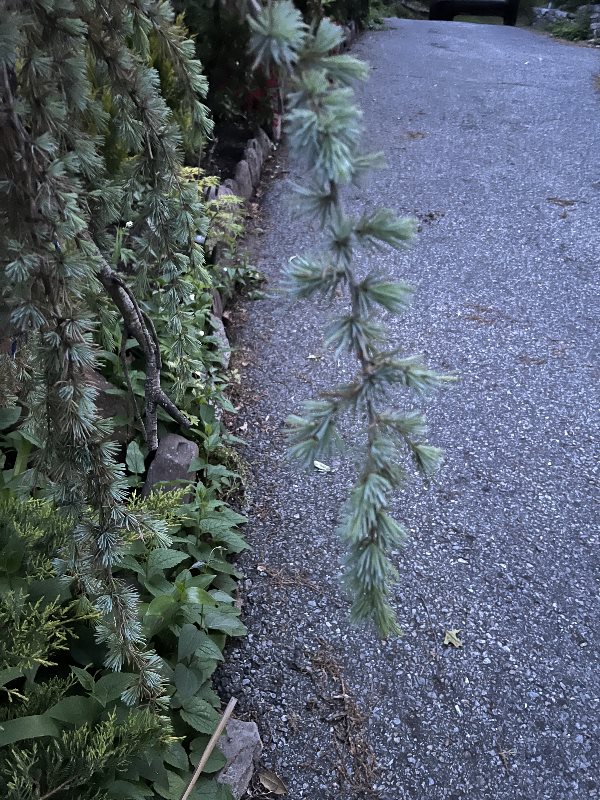
Cedrus atlantica ‘Glauca Pendula’
It is a conifer with weeping growth form, slowly reaching 15′-25′ tall and wide. Its silver blue, needle-like leaves are 1″ long and thin. Best in full sun and needs occasional watering once it’s established. Excellent for rock garden with horizontal pendant branching.
Ashley Davidoff TheCommonVein.net
Our Garden
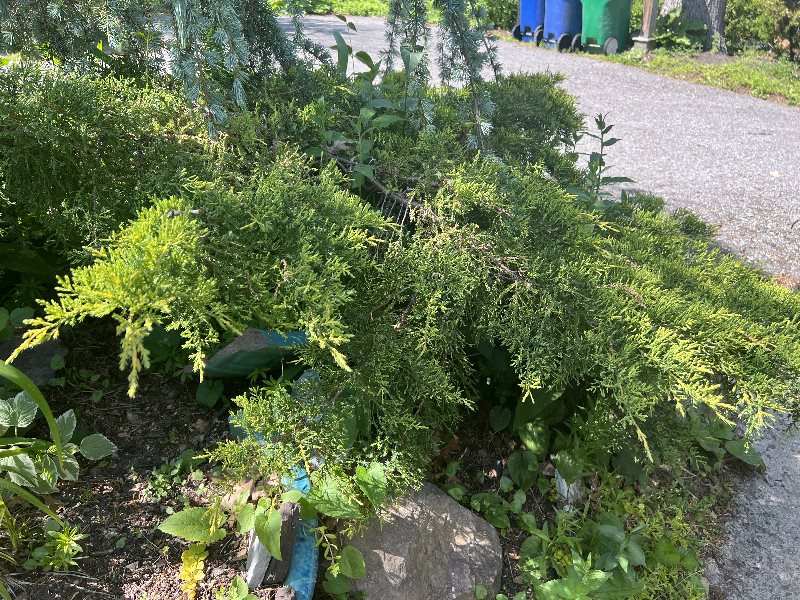
Juniperus × pfitzeriana ‘Old Gold,’ commonly known as Old Gold Juniper, is a cultivar of juniper that is prized for its attractive foliage. It is a compact, evergreen shrub that belongs to the Cupressaceae family. ‘Old Gold’ is a hybrid between Juniperus chinensis and Juniperus sabina, resulting in a plant with unique characteristics.
The most striking feature of ‘Old Gold’ Juniper is its foliage color. The scale-like leaves are a vibrant golden-yellow, which adds a bright splash of color to the landscape. In colder weather or with increased sun exposure, the foliage may take on bronze or orange tones. The foliage retains its color throughout the year, making it an excellent choice for year-round interest.
This juniper cultivar has a dense, mounding growth habit and typically reaches a height of around 2-3 feet (60-90 cm) with a similar spread. It has a moderate growth rate and is considered a low-maintenance plant. ‘Old Gold’ Juniper is often used as a ground cover, in rock gardens, or as a low hedge or border plant. Its compact size also makes it suitable for container gardening.
In terms of care, ‘Old Gold’ Juniper is adaptable to various soil types but prefers well-drained soil. It is drought-tolerant once established and has good tolerance for urban conditions. This cultivar thrives in full sun to partial shade, with full sun exposure typically resulting in the most vibrant foliage coloration. Pruning is not necessary but can be done to shape or maintain its compact form.
Overall, Juniperus × pfitzeriana ‘Old Gold’ is a popular choice for its colorful foliage, compact size, and versatility in landscaping. Whether used as a ground cover, accent plant, or hedge, it can add visual interest and bring a touch of golden warmth to any garden or landscape setting.
Ashley Davidoff TheCommonVein.net
Our Garden
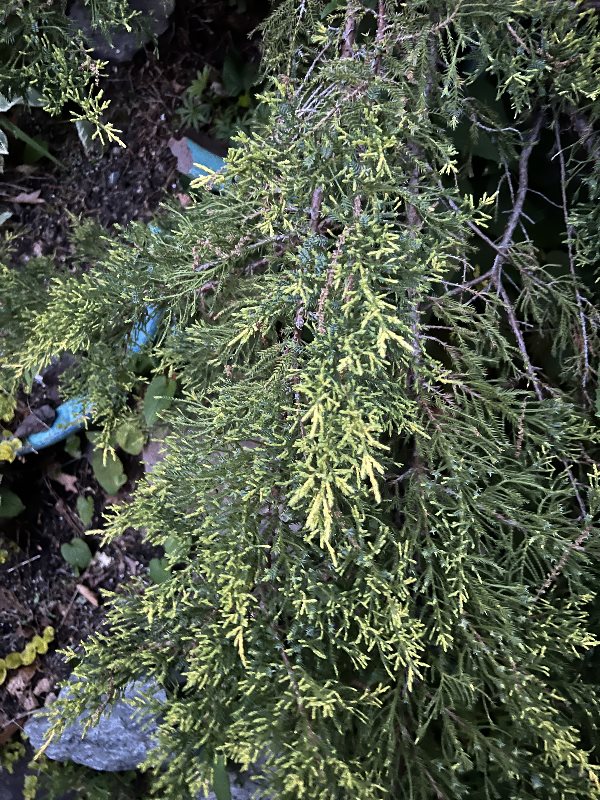
Ashley Davidoff TheCommonVein.net
Our Garden
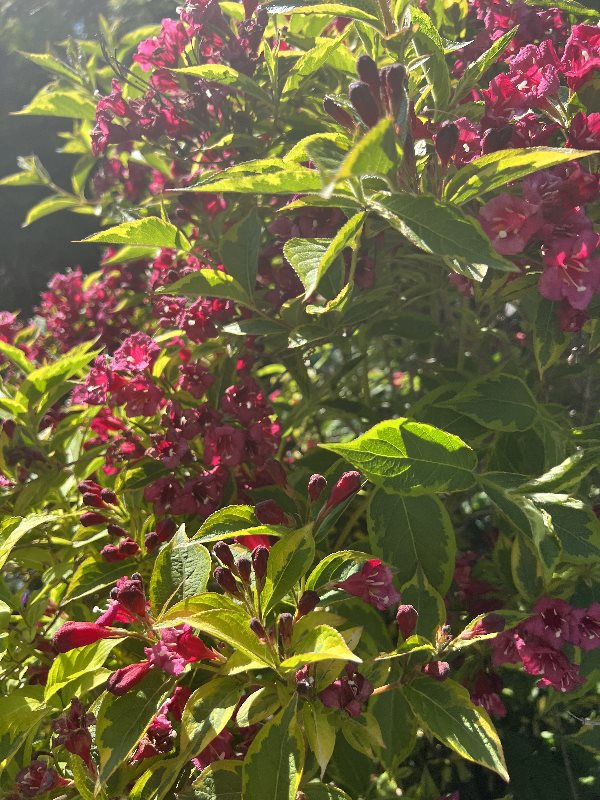
Variegated Weigela refers to a cultivar of Weigela (Weigela florida) that displays variegated foliage. The leaves of this cultivar have a combination of green and cream or yellow markings, creating a striking visual effect. The variegation adds an additional layer of interest to the plant’s appearance.
Ashley Davidoff TheCommonVein.net
Our Garden
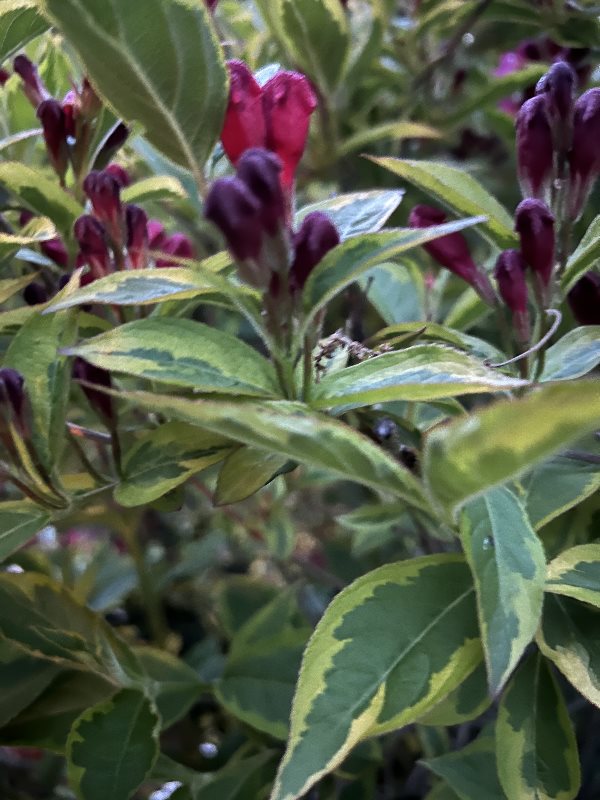
Variegated Weigela refers to a cultivar of Weigela (Weigela florida) that displays variegated foliage. The leaves of this cultivar have a combination of green and cream or yellow markings, creating a striking visual effect. The variegation adds an additional layer of interest to the plant’s appearance.
Ashley Davidoff TheCommonVein.net
Our Garden
Mountain Laurel
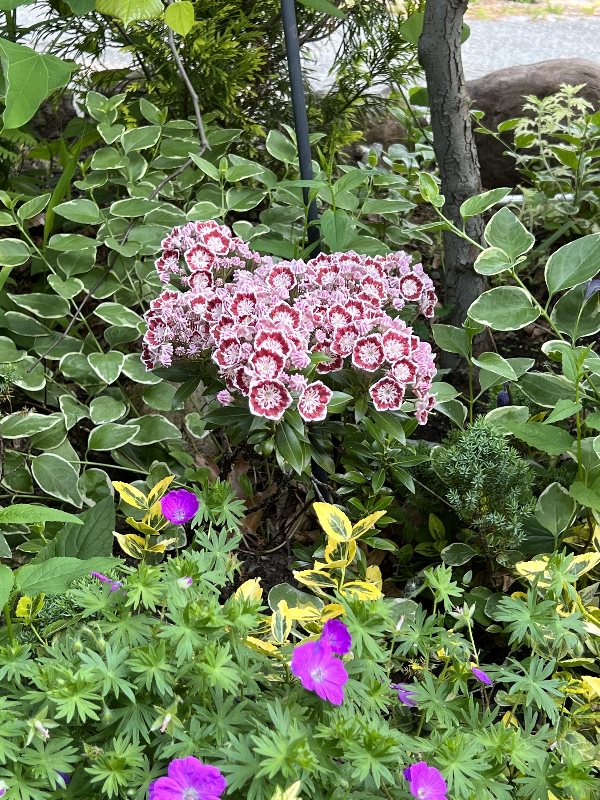
Ashley Davidoff TheCommonVein.net Our Garden
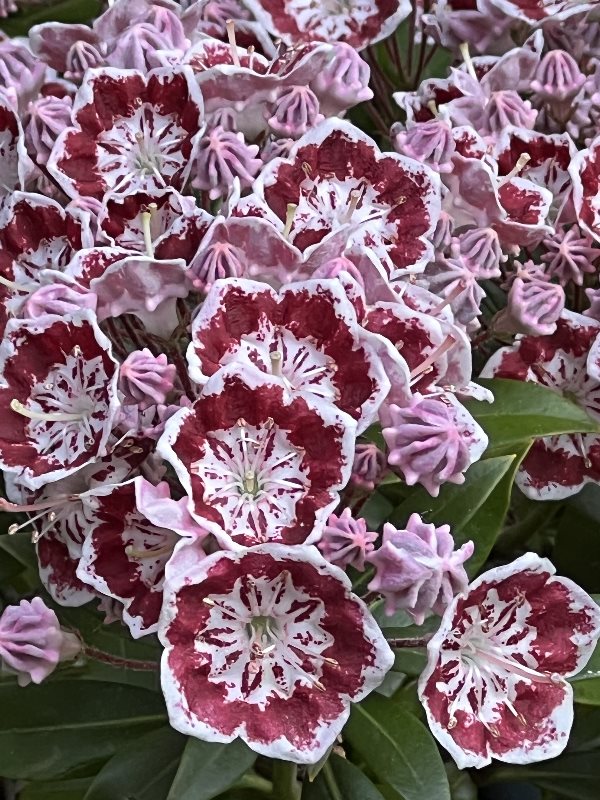
Ashley Davidoff TheCommonVein.net Our Garden
Weeping Cherry Tree
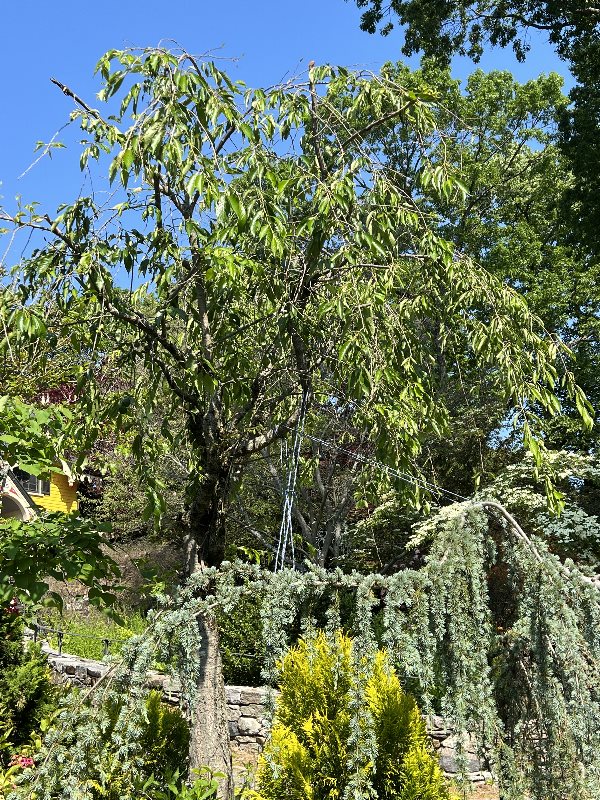
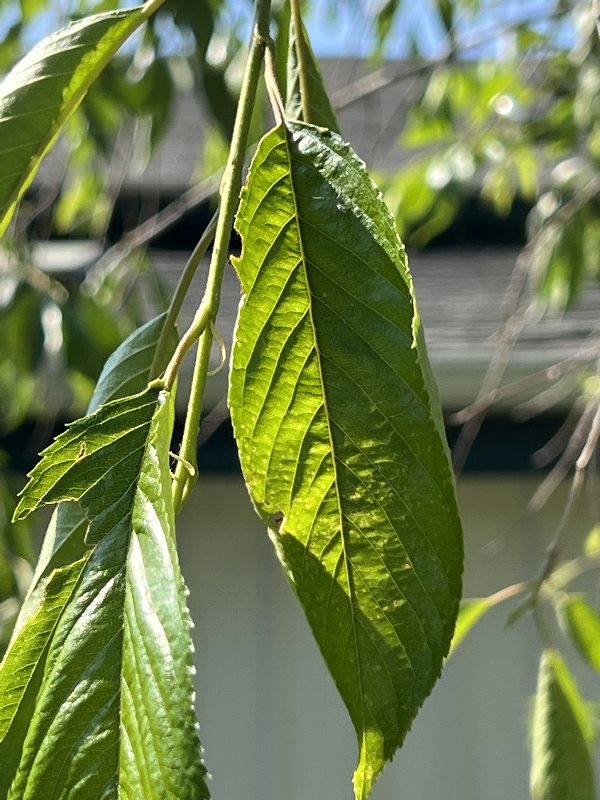
The Weeping Cherry Tree, also known as Prunus pendula or Japanese Weeping Cherry, is a popular ornamental tree appreciated for its graceful weeping branches and beautiful flowers. It is native to Japan and is widely cultivated for its aesthetic appeal.
Here are some key characteristics of the Weeping Cherry Tree:
Appearance: The Weeping Cherry Tree has a distinctive weeping habit, with long, cascading branches that droop towards the ground. The branches are covered in dark green, serrated leaves that create a dense canopy. During the spring season, the tree bursts into a profusion of delicate, pink or white blossoms, creating a stunning visual display.
Size: The size of a mature Weeping Cherry Tree can vary depending on the specific cultivar and growing conditions. On average, they reach a height of around 15 to 25 feet (4.5 to 7.6 meters) and have a similar spread.
Growing Conditions: Weeping Cherry Trees thrive in full sunlight, although they can tolerate partial shade. They prefer well-draining soil that is moist but not waterlogged. They are generally hardy and can adapt to different soil types. However, they are best suited for temperate regions with mild climates.
Care and Maintenance: Proper care is important to ensure the health and vitality of a Weeping Cherry Tree. Regular watering, especially during dry periods, is necessary to keep the soil adequately moist. Pruning is typically done during late winter or early spring to remove dead or damaged branches and to maintain the tree’s shape. It is important to note that the branches are relatively fragile and can be susceptible to damage, so care should be taken when handling them.
Arborvitae, also known as Thuja
Thuja plicata
(Western Arborvitae or Western Red Cedar)
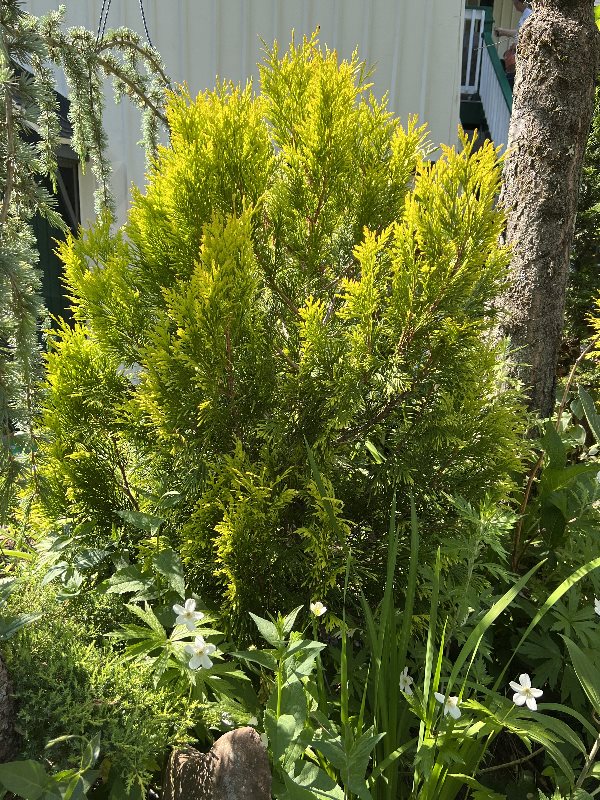
Western Red Cdar Arborvitae Conifer
Ashley Davidoff TheCommonVein.net Our Garden
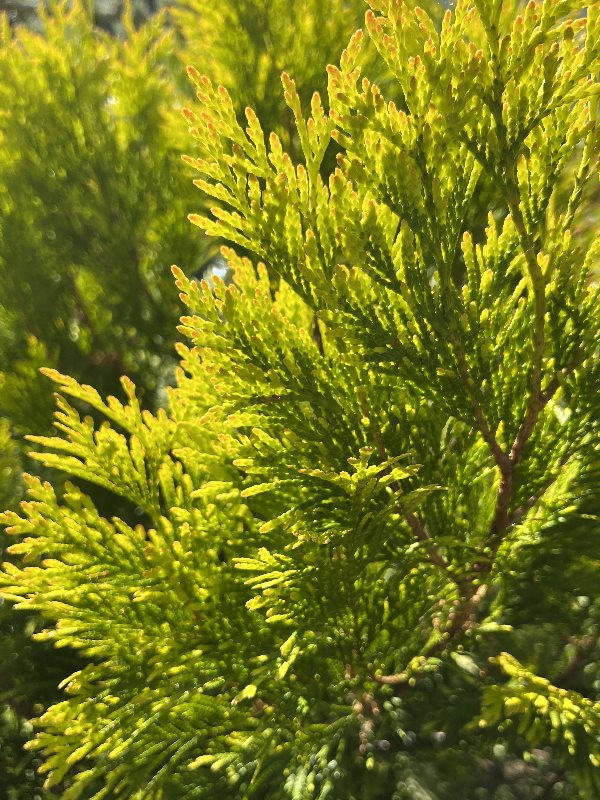
Western Red Cdar Arborvitae Conifer
Ashley Davidoff TheCommonVein.net Our Garden
Arborvitae, also known as Thuja, is a genus of evergreen coniferous trees and shrubs belonging to the cypress family (Cupressaceae). The term “arborvitae” itself is derived from the Latin words “arbor” (tree) and “vitae” (life) and translates to “tree of life.” The name reflects the longevity and evergreen nature of these plants.
Arborvitae conifers are characterized by their dense foliage, which consists of scale-like or needle-like leaves that are typically arranged in flattened sprays. They have a conical or columnar shape and can vary in size depending on the species and cultivar.
These conifers are popular in landscaping and gardening due to their attractive appearance and ease of cultivation. They are commonly used as ornamental trees or shrubs in gardens, hedges, screens, and windbreaks. Arborvitae species are known for their resilience and ability to adapt to various growing conditions. They are native to North America and eastern Asia.
One of the most well-known species is Thuja occidentalis, commonly known as Eastern Arborvitae or American Arborvitae. It is native to eastern North America and is widely cultivated for its compact size, dense foliage, and tolerance to cold temperatures. Other notable species include Thuja plicata (Western Arborvitae or Western Red Cedar) and Thuja orientalis (Oriental Arborvitae).
Arborvitae conifers are valued not only for their aesthetic appeal but also for their practical uses. Their wood is lightweight, durable, and resistant to decay, making it suitable for various applications such as construction, furniture, and fence posts.
In summary, arborvitae conifers are a group of evergreen trees and shrubs known for their dense foliage, conical shape, and adaptability. They are commonly used in landscaping and have both ornamental and practical uses.
Sambucus racemosa ‘Lemony Lace’
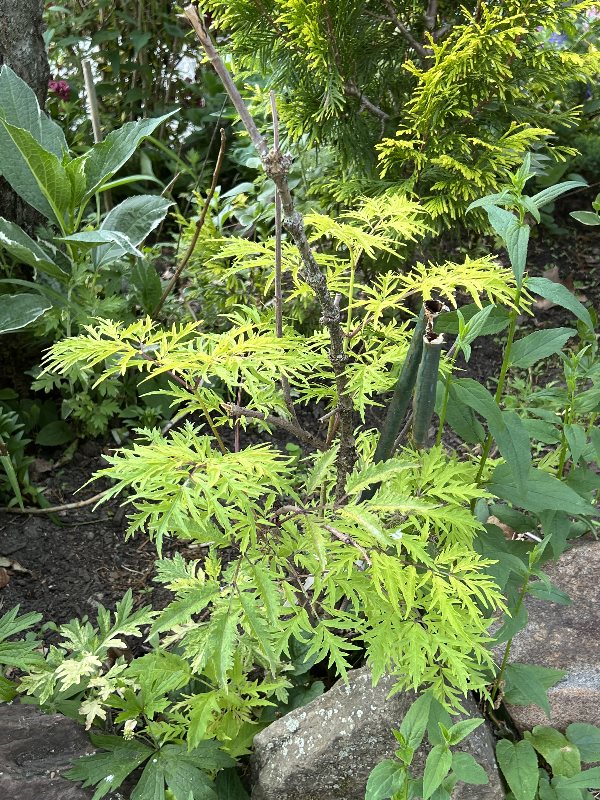
Ashley Davidoff TheCommonVein.net Our Garden
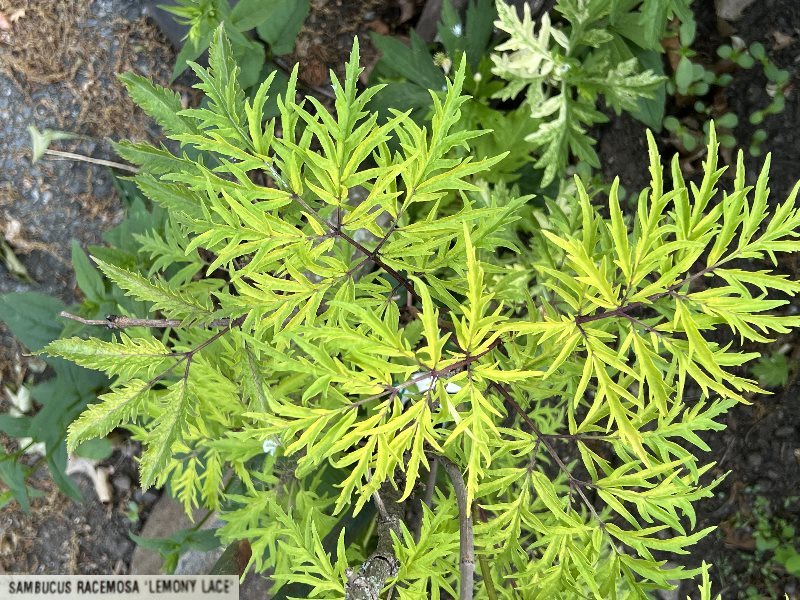
Ashley Davidoff TheCommonVein.net Our Garden
Sambucus racemosa ‘Lemony Lace’ is a cultivar of the Red Elderberry or European Red Elder (Sambucus racemosa). It is a deciduous shrub known for its striking golden foliage and delicate lace-like appearance.
Here are some key features of Sambucus racemosa ‘Lemony Lace’:
Appearance: ‘Lemony Lace’ is prized for its finely dissected leaves that have a lacy texture. The foliage emerges as a bright chartreuse or yellow-green color in spring and matures to a golden yellow shade as the season progresses. The leaflets are deeply cut, giving them a feathery appearance. In early summer, clusters of small creamy-white flowers appear, which are followed by small red berries in late summer to early fall.
Size: This cultivar typically grows as a compact, mounding shrub, reaching a height and spread of around 3 to 5 feet (0.9 to 1.5 meters). Its compact size makes it suitable for small gardens or as a container plant.
Growing Conditions: ‘Lemony Lace’ thrives in full sun to partial shade conditions. It prefers well-drained soil that is rich in organic matter. It is relatively adaptable to different soil types and can tolerate both wet and dry conditions. It is hardy in USDA hardiness zones 3 to 7.
Care and Maintenance: This shrub is generally low-maintenance. Regular watering is recommended, especially during dry periods, to keep the soil consistently moist. Pruning can be done in late winter or early spring to maintain its shape and remove any dead or damaged branches.
Landscape Use: Sambucus racemosa ‘Lemony Lace’ is a versatile shrub that can be used in various garden settings. Its vibrant foliage and delicate texture make it an eye-catching focal point or a colorful addition to mixed borders, rock gardens, or woodland gardens. It can also be utilized in mass plantings or as a low hedge. The red berries produced by the plant are attractive to birds and can provide wildlife interest.
It’s important to note that while the berries of the Red Elderberry are not suitable for human consumption, they can be attractive to birds and wildlife.
Overall, Sambucus racemosa ‘Lemony Lace’ is valued for its vibrant golden foliage, lacy appearance, and adaptability. Its unique characteristics make it a sought-after choice for adding texture and color to gardens and landscapes.
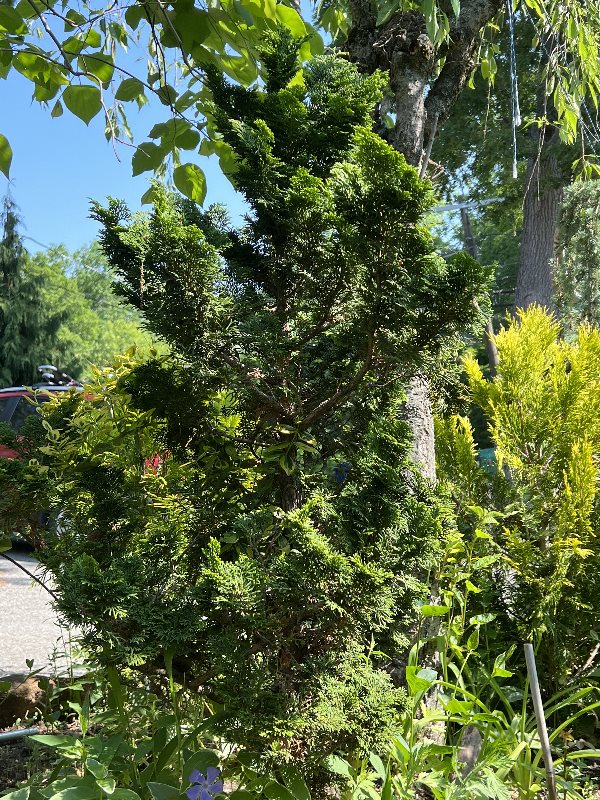
Chamaecyparis Obtusa Confucius
Ashley Davidoff TheCommonVein.net Our Garden
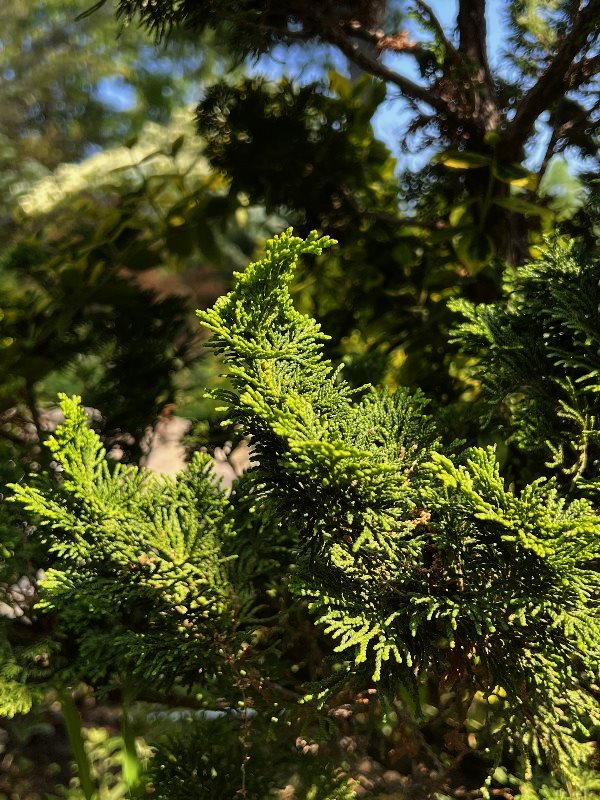
Chamaecyparis Obtusa Confucius
Ashley Davidoff TheCommonVein.net Our Garden
Hinoki Cypress (Chamaecyparis obtusa) is a species of evergreen coniferous tree native to Japan. It is highly valued for its elegant, dense foliage, unique texture, and pleasant aroma. One popular cultivar of Hinoki Cypress is Chamaecyparis obtusa ‘Confucius,’ which exhibits distinct color variations compared to the typical species.
Here are some key characteristics of Chamaecyparis obtusa ‘Confucius’:
Appearance: ‘Confucius’ is known for its vibrant golden-yellow foliage, which stands out in the landscape. The foliage retains its color throughout the year, providing a striking contrast to other green plants in the garden. The branches are densely arranged, forming a compact, pyramidal shape. As the tree matures, it can reach heights of around 10 to 20 feet (3 to 6 meters) and have a spread of about 5 to 10 feet (1.5 to 3 meters).
Growth Rate: ‘Confucius’ has a slow to moderate growth rate, making it a suitable choice for smaller gardens or as a focal point in a landscape.
Hardiness and Adaptability: Hinoki Cypress is hardy in USDA hardiness zones 5 to 8. It prefers full to partial sun and well-draining soil. It can tolerate a range of soil types, including clay and loam. Hinoki Cypress is generally resistant to pests and diseases, adding to its overall resilience.
Aroma: The wood and foliage of Hinoki Cypress emit a distinctive fragrance often described as lemony or spicy. This pleasant scent is highly regarded and is one of the reasons this tree is valued in traditional Japanese culture.
Landscape Use: Chamaecyparis obtusa ‘Confucius’ is commonly used in gardens and landscapes for its ornamental qualities. Its golden-yellow foliage adds visual interest and can create a focal point or a contrasting element in the garden. It can be planted as a specimen tree, as part of mixed borders, or in rock gardens. Hinoki Cypress is also well-suited for container planting and can be shaped or pruned to maintain its desired form.
Hinoki Cypress, including the ‘Confucius’ cultivar, is treasured for its beauty, durability, and cultural significance in Japanese gardens. Its striking golden color, unique texture, and aromatic qualities make it a popular choice for adding elegance and charm to various garden settings.
The Weeping Red Bud, or Cercis canadensis ‘Lavender Twist,’ is a popular cultivar of the Eastern Red Bud tree. It is known for its unique weeping growth habit, which sets it apart from the typical upright form of the species. The Weeping Red Bud is cherished for its graceful cascading branches, beautiful spring flowers, and attractive foliage.
Here are some key features of the Weeping Red Bud:
Appearance: The Weeping Red Bud showcases a weeping or pendulous form, with its branches gracefully arching downward. It typically reaches a height of around 6 to 10 feet (1.8 to 3 meters) and spreads out to create an elegant canopy. The heart-shaped leaves emerge as a reddish-purple color in spring, gradually transitioning to a deep green as summer approaches. In early spring, clusters of pink to lavender flowers appear directly on the branches before the leaves emerge, adding a splash of color to the landscape.
Growing Conditions: Weeping Red Bud trees thrive in full sunlight to partial shade. They prefer well-draining soil but are adaptable to various soil types. They are relatively hardy and can tolerate a range of temperatures and climates, making them suitable for different regions. Regular watering and mulching are recommended to help maintain soil moisture.
Care and Maintenance: The Weeping Red Bud requires minimal maintenance once established. Pruning may be necessary to maintain the desired weeping form and remove any dead or crossing branches. Pruning is typically done in late winter or early spring before new growth emerges. Regular watering during dry periods and a layer of mulch around the base of the tree can help retain soil moisture and support healthy growth.
Landscape Use: The Weeping Red Bud is a popular choice for adding visual interest and elegance to gardens, landscapes, and even smaller spaces. Its weeping branches and striking flowers make it a captivating focal point or specimen tree. It can be planted as a standalone tree or in groupings to create a dramatic effect. It is also suitable for planting near ponds, water features, or in woodland gardens.
Green Giant Arborvitae
Thuja plicata
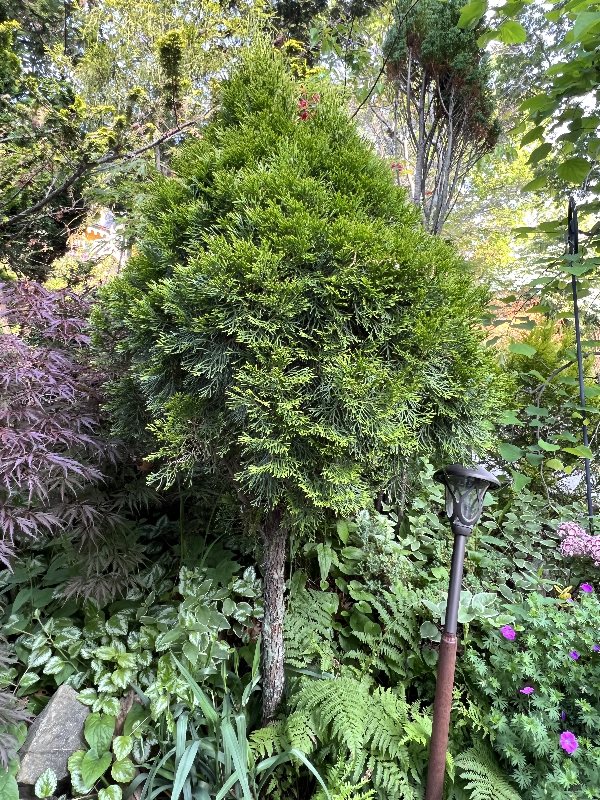
Thuja plicata
The base of the tree has been trimmed
Ashley Davidoff TheCommonVein.net Our Garden
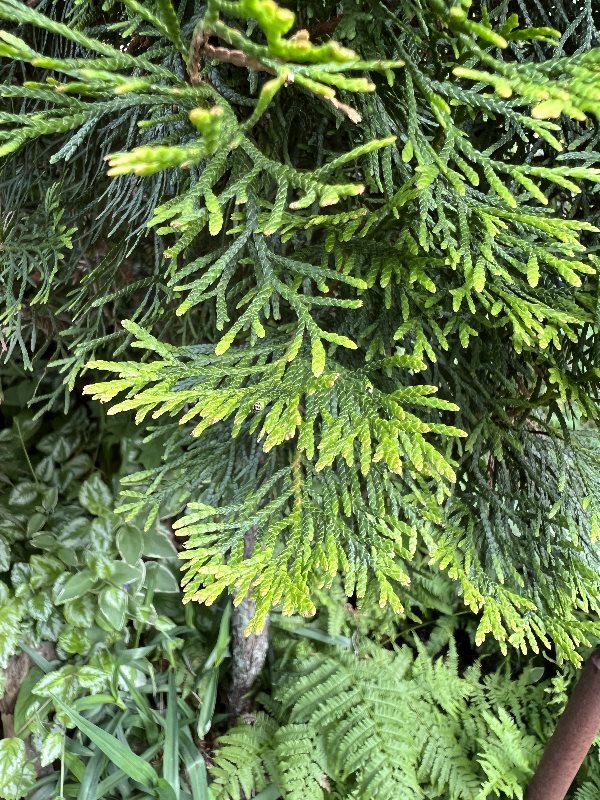
Thuja plicata
Ashley Davidoff TheCommonVein.net Our Garden
The Green Giant Arborvitae, also known as Thuja ‘Green Giant’ (Thuja plicata × Thuja standishii ‘Green Giant’), is a popular evergreen tree cultivar. It is a hybrid resulting from a cross between Western Red Cedar (Thuja plicata) and Japanese Arborvitae (Thuja standishii).
Here are some key characteristics of the Green Giant Arborvitae:
Appearance: The Green Giant Arborvitae is known for its fast growth rate and large size. It has a tall, pyramidal shape and can reach heights of up to 60 to 80 feet (18 to 24 meters) at maturity, with a spread of about 15 to 20 feet (4.5 to 6 meters). The foliage consists of flattened, scale-like leaves that are deep green in color.
Growth Rate: One of the notable features of the Green Giant Arborvitae is its rapid growth. It is considered one of the fastest-growing evergreen trees, with an average growth rate of around 3 to 5 feet (0.9 to 1.5 meters) per year under ideal conditions. This characteristic makes it an attractive choice for creating privacy screens, windbreaks, or for quickly establishing a green barrier in a landscape.
Hardiness and Adaptability: The Green Giant Arborvitae is highly adaptable and can tolerate a wide range of growing conditions. It is hardy in USDA hardiness zones 5 to 8. It can thrive in full sun to partial shade and prefers well-drained soil, but it can tolerate a variety of soil types, including clay and sandy soils.
Disease and Pest Resistance: The Green Giant Arborvitae is known for its excellent resistance to many common diseases and pests that can affect arborvitae species. It is relatively resistant to damage from deer browsing, as well.
Landscape Use: Due to its rapid growth and dense foliage, the Green Giant Arborvitae is often used as a privacy screen, windbreak, or living fence. It can effectively block unwanted views, reduce noise, and create a sense of seclusion in a landscape. Its large size and attractive appearance also make it suitable as a specimen tree or for adding vertical interest to a garden.
When considering planting the Green Giant Arborvitae, it’s important to provide adequate spacing for its mature size and ensure regular watering during its establishment phase. Additionally, proper pruning may be necessary to maintain its desired shape and size.
Japanese Maple Acer palmatum ‘Dissectum’
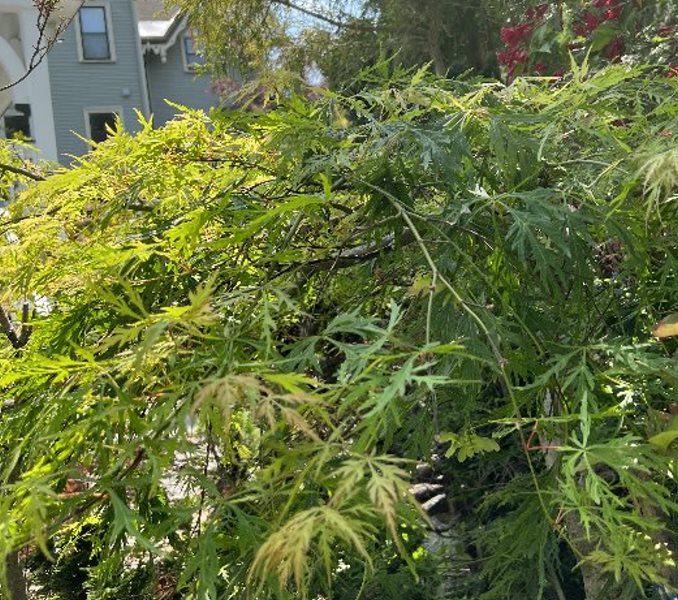
Ashley Davidoff TheCommonVein.net Our Garden’
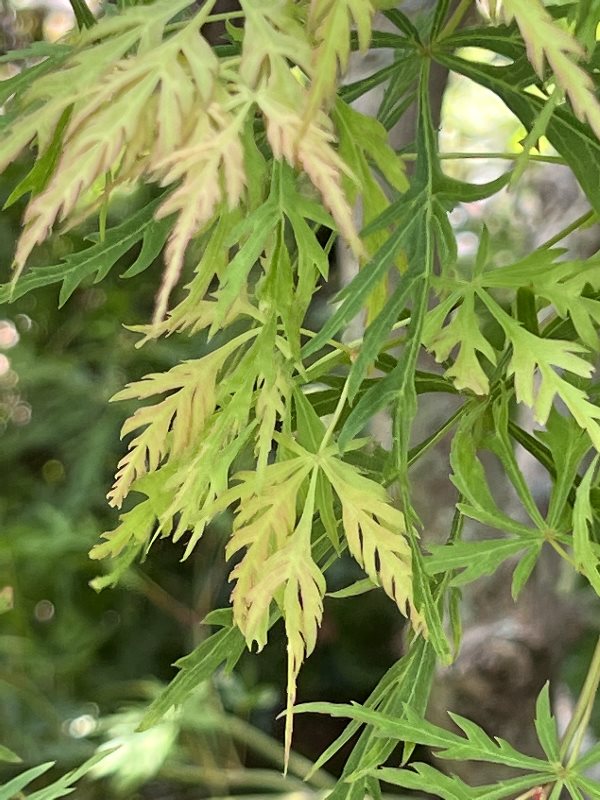
Ashley Davidoff TheCommonVein.net Our Garden’
The Japanese Maple, Acer palmatum ‘Dissectum,’ is a beautiful and popular cultivar known for its delicate, finely cut foliage and graceful, cascading form. It is a variety of the Acer palmatum species, which is native to Japan, Korea, and China. Here’s some information about the Japanese Maple ‘Dissectum’:
- Appearance: The ‘Dissectum’ cultivar is characterized by its deeply dissected, feathery leaves. The leaves have a lace-like appearance, with serrated edges and multiple lobes. They typically emerge with a reddish or bronze color in spring, turn green during summer, and develop vibrant shades of red, orange, or yellow in autumn. The tree has a low, spreading habit, with cascading branches that create an elegant and picturesque silhouette.
- Size: Japanese Maple ‘Dissectum’ is a small to medium-sized tree, typically reaching a height of 6 to 10 feet (1.8 to 3 meters) and a spread of 8 to 12 feet (2.4 to 3.7 meters). However, its size can vary depending on growing conditions and pruning practices.
- Growing Conditions: ‘Dissectum’ is generally well-suited for growing in USDA hardiness zones 5 to 8, although specific cultivars may have different tolerances. It thrives in partial shade or dappled sunlight, as excessive sun exposure can scorch the delicate foliage. The soil should be well-draining, moist, and rich in organic matter. It’s important to protect the tree from strong winds, as its delicate branches are prone to damage.
Japanese Maple ‘Dissectum’ is a stunning tree that adds elegance and beauty to any landscape. Its unique foliage and graceful form make it a cherished addition to gardens around the world.
Buxus microphylla japonica ‘Green Beauty’ is a specific cultivar of the Japanese Boxwood, a variety of boxwood known for its small leaves and compact growth habit.
Appearance: ‘Green Beauty’ is characterized by its dense, dark green foliage. The small leaves are oval-shaped and have a glossy texture. The plant has a rounded, compact growth habit, making it suitable for hedges, borders, and topiary. The foliage retains its green color throughout the year, providing year-round interest in the landscape.
- Size: ‘Green Beauty’ typically grows to a height of 3 to 4 feet (0.9 to 1.2 meters) and has a similar spread. However, its size can be controlled through pruning, allowing it to be maintained at a desired height and shape.
- Growing Conditions: ‘Green Beauty’ Japanese Boxwood thrives in partial shade to full sun conditions. It prefers well-draining soil with good moisture retention. Regular watering is important, especially during dry periods. This cultivar is hardy in USDA hardiness zones 5 to 9.
Buxus microphylla japonica ‘Green Beauty’ is valued for its attractive, deep green foliage and versatility in the landscape.
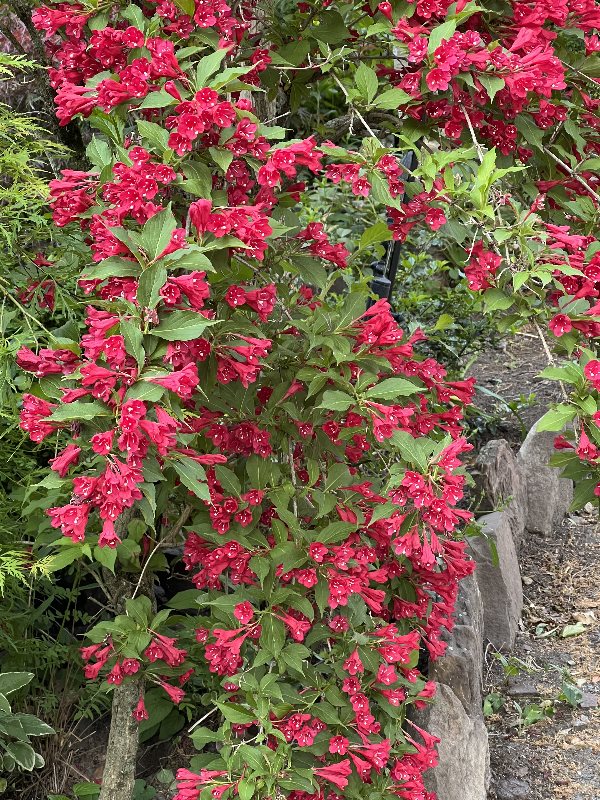
Weigela florida ‘Red Prince’
Ashley Davidoff TheCommonVein.net Our Garden’
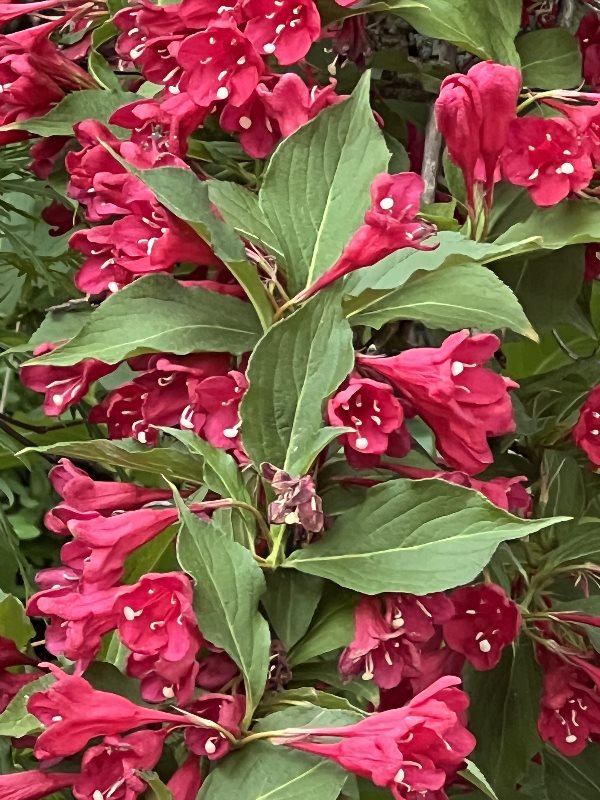
Weigela florida ‘Red Prince’
Ashley Davidoff TheCommonVein.net Our Garden’
Weigela florida ‘Red Prince’ is a specific cultivar of Weigela, a deciduous shrub known for its showy flowers and attractive foliage. Here’s some information about Weigela florida ‘Red Prince’:
- Appearance: ‘Red Prince’ features vibrant red trumpet-shaped flowers that bloom profusely in late spring to early summer. The flowers are clustered together in terminal racemes and create a stunning display against the backdrop of the shrub’s dark green leaves. The foliage is ovate to elliptical in shape and has a slightly serrated edge. In the fall, the leaves may take on a reddish tint, adding to the plant’s visual interest.
- Size: ‘Red Prince’ typically grows to a height of 5 to 6 feet (1.5 to 1.8 meters) with a similar spread. It has an upright and rounded growth habit. The shrub can be pruned to maintain a desired shape and size.
- Growing Conditions: ‘Red Prince’ thrives in full sun to partial shade conditions. It prefers well-draining soil with average moisture levels. Once established, it has good drought tolerance. This cultivar is hardy in USDA hardiness zones 4 to 8.
- Care and Maintenance: Here are some care guidelines for Weigela florida ‘Red Prince’:
- Watering: Provide regular watering during the establishment period and in dry periods. Once established, it is moderately drought tolerant but benefits from occasional deep watering during prolonged dry spells.
- Mulching: Apply a layer of organic mulch around the base of the shrub to help retain moisture, regulate soil temperature, and suppress weeds.
- Fertilization: Apply a balanced slow-release fertilizer in early spring to provide necessary nutrients. Follow the manufacturer’s instructions for application rates.
- Pruning: ‘Red Prince’ blooms on old wood, so prune immediately after flowering to shape the shrub and remove any dead or damaged branches. Avoid heavy pruning in late summer or fall, as it may remove potential flower buds for the next season.
- Protection: Monitor the shrub for any pest or disease issues and take appropriate measures if necessary. Weigela is generally resistant to many common pests and diseases.
- Landscape Use: Weigela florida ‘Red Prince’ is a popular choice for adding vibrant color to gardens and landscapes. It can be used as a focal point, in borders, or as a hedge. The attractive flowers and foliage make it an excellent choice for mixed shrub borders and cottage gardens.
Weigela florida ‘Red Prince’ is a stunning cultivar that adds a burst of vibrant red to the landscape with its profuse flowers. With its low-maintenance nature and versatility, it is a popular choice for gardeners looking to enhance their outdoor spaces with eye-catching blooms.
Hinoki?
Japanese Red Maple
Acer Palmatum Dissectum ‘Garnet” Cutleaf
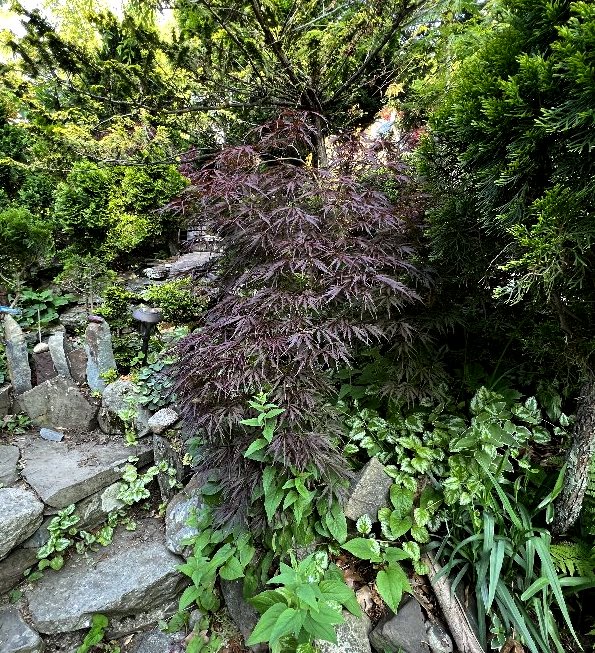
Ashley Davidoff TheCommonVein.net Our Garden
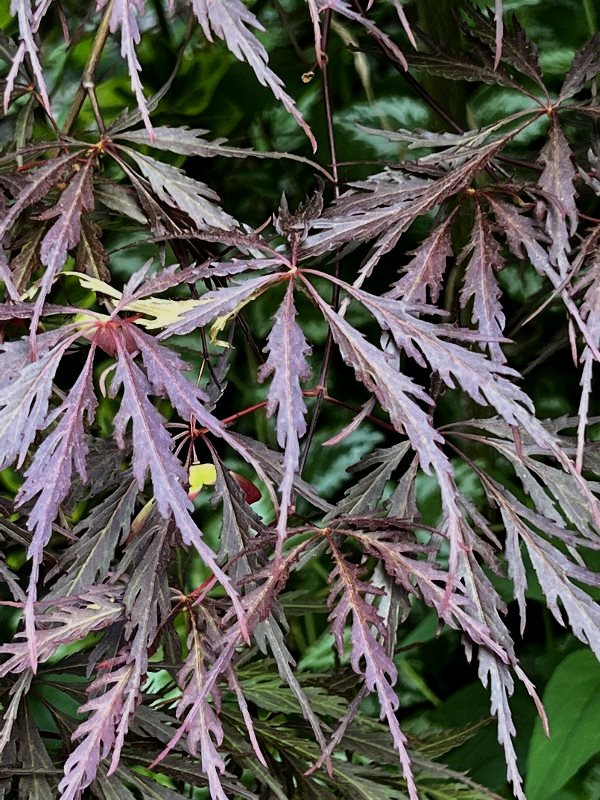
Ashley Davidoff TheCommonVein.net Our Garden
Holly
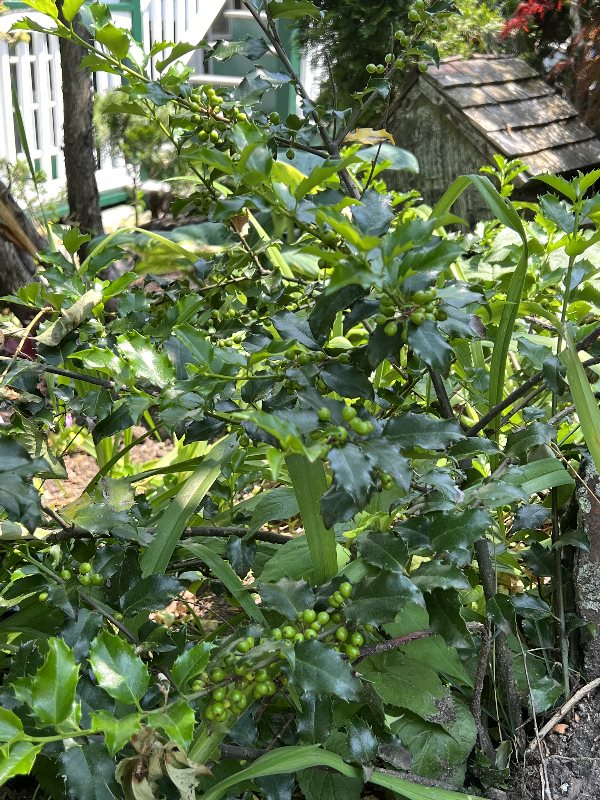
Ashley Davidoff TheCommonVein.net Our Garden’
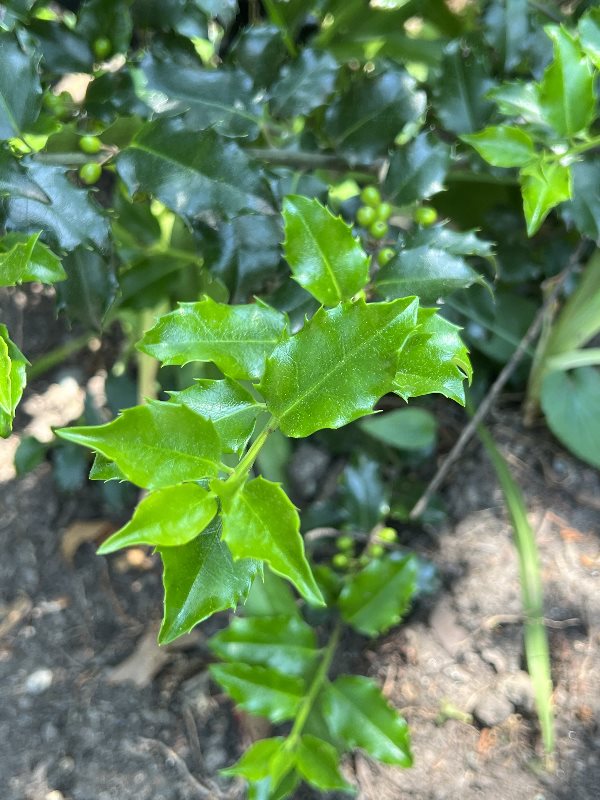
Ashley Davidoff TheCommonVein.net Our Garden’
Common Holly (Ilex aquifolium) is an evergreen shrub or small tree native to Europe, including regions such as the British Isles. It is known for its glossy, spiky leaves, bright red berries, and its association with traditional holiday decorations. Here’s some information about Common Holly:
- Appearance: Common Holly has shiny, dark green leaves that are leathery and have a distinctive spiny or serrated edge. The leaves are typically oval or elliptical in shape and arranged alternately on the stems. Female plants produce vibrant red berries that ripen in the fall and persist throughout the winter. The berries are a favorite food source for birds. The plant can reach a height of 15 to 50 feet (4.5 to 15 meters) depending on growing conditions and pruning practices.
- Growing Conditions: Common Holly is adaptable to a variety of soil types but prefers well-draining soil. It can tolerate both full sun and partial shade, although it may have denser foliage and more berries in full sun. It is generally hardy in USDA hardiness zones 6 to 9. Common Holly is dioecious, which means it has separate male and female plants. Female plants produce the characteristic red berries, while male plants produce small, inconspicuous flowers.
- Protection: Common Holly is generally resistant to pests and diseases. However, it may occasionally be affected by pests like scale insects or diseases like leaf spot.
- Landscape Use: Common Holly is a popular choice for both ornamental and practical purposes in landscapes. Its dense foliage and vibrant berries make it a beautiful addition to gardens and provide year-round interest. It can be used as a specimen plant, in hedges, or as a privacy screen. The branches with berries are often cut and used in holiday decorations like wreaths and garlands.
Note: While the berries of Common Holly are attractive, they are toxic to humans and many animals. It is important to exercise caution and keep them out of reach of children and pets.
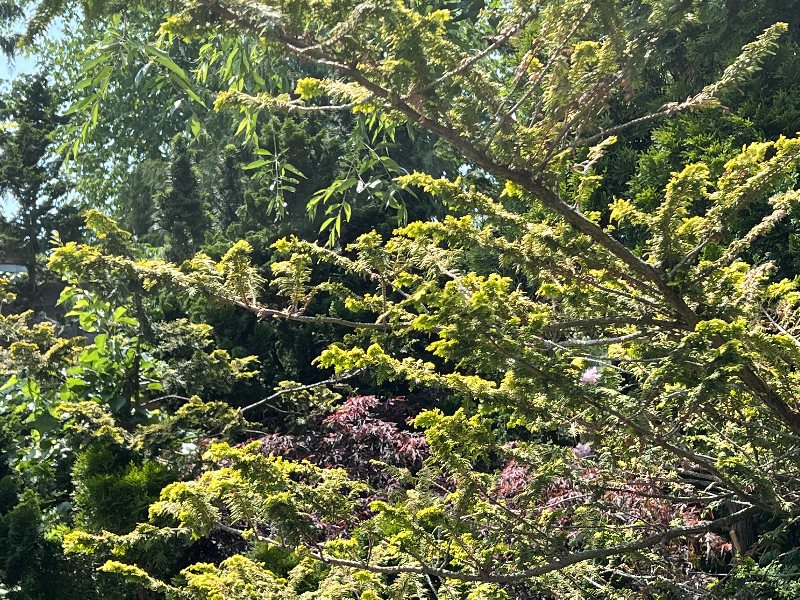
Chamaecyparis obtusa ‘Gold Fern’
Ashley Davidoff TheCommonVein.net Our Garden’
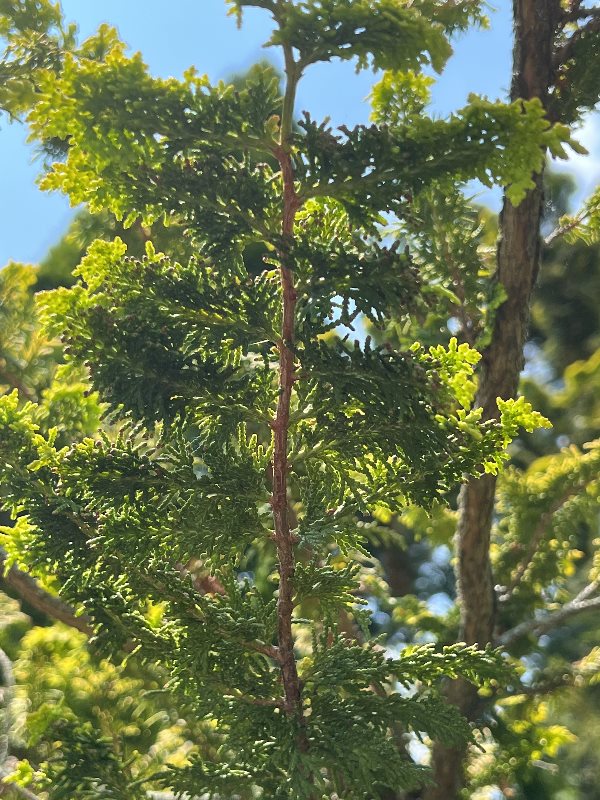
Chamaecyparis obtusa ‘Gold Fern’
Ashley Davidoff TheCommonVein.net Our Garden’
Chamaecyparis obtusa ‘Gold Fern’ is a specific cultivar of the Hinoki Falsecypress, a beautiful evergreen coniferous tree native to Japan. It is known for its striking golden foliage and compact growth habit. Here’s some information about Chamaecyparis obtusa ‘Gold Fern’:
- Appearance: ‘Gold Fern’ has vibrant golden-yellow foliage that stands out in the landscape. The foliage consists of flattened sprays of scale-like leaves that have a fern-like appearance. The leaves are soft to the touch and emit a pleasant fragrance when crushed. This cultivar maintains its golden color throughout the year, adding visual interest to the garden.
- Size: ‘Gold Fern’ typically grows as a small to medium-sized tree, reaching a height of 10 to 20 feet (3 to 6 meters) with a spread of 6 to 8 feet (1.8 to 2.4 meters) over time. It has a compact, pyramidal growth habit, making it suitable for smaller gardens or as a specimen plant in larger landscapes.
- Growing Conditions: ‘Gold Fern’ thrives in full sun to partial shade conditions. It prefers well-draining soil that is kept evenly moist but not waterlogged. It is generally hardy in USDA hardiness zones 4 to 8, although specific regional variations may apply. This cultivar has good resistance to deer and is considered relatively low-maintenance.
Chamaecyparis obtusa ‘Gold Fern’ is a stunning cultivar of the Hinoki Falsecypress that brings a touch of golden elegance to any landscape. Its compact size, attractive foliage, and low-maintenance nature make it a popular choice among gardeners and landscape designers.
Eastern Arbor Vitae
Goldcrest Monterey Cypress
Dogwood Pink Flowers
Weeping Cherries
Arbor Vitae
Common Yew or European Yew tree (Taxus baccata)
Dark Green vertical Yew with Red Berries
Yews, Taxus, plants are conifers, so they produce cones, along with red berries. They feature evergreen needles in two primary forms, a spreading shrub or a tall columnar tree. They have a relatively fast growth rate that slows as the plant matures. This type of plant has been around for over 200 million years. Yes, they existed with dinosaurs! Female yews produce small red berries that surround a single (toxic) seed, The plant attracts birds to eat the fruit, the flesh of which is the only part of the plant that is not toxic.
Slender Hinoki Cypress Tree
Chamaecyparis obtusa ‘Gracilis’
Verdoni Hinoki Cypress
Golden Hinoki Cypress
Variegated Hydrangea
Rose
Weeping Redbud
Mountain Laurel
Rhodendron Pink
Rhodendron Pink
Rose of Sharon Lucy
Magnolia ?
Japanese Boxwood

